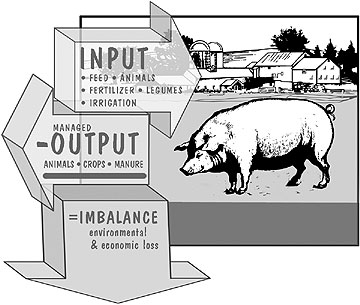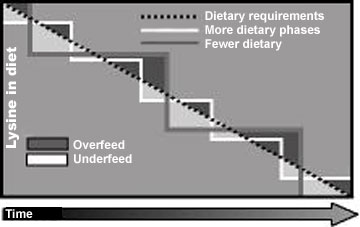The trend toward intensive swine production has raised concerns about concentrated production of manure. These concerns are challenging pork producers to adopt not only improved manure management methods but also methods for reducing the amount of nutrients fed in excess of the pigs' dietary requirements.
Swine researchers are working to develop answers to problems of environmental contamination. Research shows that attention to the nutrient content of swine diets can help to maintain a healthy environment and reduce feeding costs.
Farm nutrient balancing

It is important to maintain a balance of nutrients on the farm. Producers should take into account all nutrients coming into and leaving the farm (Figure 1). Nutrient inputs in the form of feed, fertilizer and feeder animals, for example, must balance outputs such as crops, manure and animals for market. An imbalance results in soil contamination and a loss to the environment.
Various techniques can be used to minimize excretion of nutrients in swine production. Adjusting the physical characteristics of the feed by adjusting its fineness or by pelleting can enhance digestibility and minimize feed wastage. By feeding synthetic amino acids at specific concentrations that meet the ideal amino acid ratio, producers can then manipulate swine diets to better meet nutritional requirements recommended by the National Research Council (Nutrient Requirements of Swine: 10th Revised Edition. Washington, D.C.: National Academy Press. 1998). Use of the dietary enzyme phytase can make more of the phosphorus in feed available to an animal and in this way reduce the amount of phosphorus excreted.
Feeding regimes can also influence how effectively a diet meets nutrient requirements and reduces excretion. Phase feeding and split-sex feeding, for example, can greatly decrease nutrient waste. In theory, these techniques enable a swine producer to adjust diet according to a pig’s needs, thus minimizing nutrients fed in excess. In practice, however, producers cannot achieve ideal adjustments in swine diet because they do not know the exact nutrient requirements and daily feed intake of individual pigs and because of losses in feed delivery systems and the grouping of animals in pens. For these reasons, producers strive for long-term, overall effectiveness in their feeding programs.
Phase and split-sex feeding

Phase feeding is used in swine production to meet the nutrient needs of growing pigs with accuracy. As the animals grow, their requirements for amino acids and minerals decrease as a percentage of their diet. The goal of phase feeding is to adjust diets incrementally to more closely meet the animals’ changing dietary requirements at various stages of their development. Frequent adjustment (smaller phases) will reduce overfeeding and underfeeding of nutrients (Figure 2). This, in turn, reduces excretion of excess nutrients. When adjusting the diet, it is important to avoid large, sudden changes, which cause production to lag as the pigs adapt to the new diet.
Split-sex feeding can benefit nutrient use also. Gilts make more efficient use of feed and take in a smaller amount of feed than barrows do, but they require the same amount of nutrients per body weight. Gilts require a more nutrient-dense diet to match the growth performance of barrows, because gilts have a lower feed intake and a higher percentage of lean. These differences show the importance of segregating pigs according to sex during the grow phase of production. Table 1 shows the extent to which various dietary manipulation techniques can decrease the amount of nitrogen and phosphorus excreted.
Table 1
Estimated reduction in nutrients excreted.
- Phase or split-sex feeding
Nitrogen 20 to 30 percent Phosphorus 5 to 10 percent - Phytase enzyme supplement
Nitrogen 5 to 10 percent Phosphorus30 to 60 percent - Amino acid manipulation
Nitrogen 30 to 50 percent Phosphorus not determined or no data available - Pelleting or fineness adjustment
Nitrogen 20 to 25 percent Phosphorus not determined or no data available
Accurate knowledge of nutrients in feed sources
A pork producer must always be aware of the nutrient components in the feed sources being used. Because the concentrations of some nutrients can fluctuate with differences in growing conditions when a feed crop was being produced, it is important to analyze random samples. For example, the amount of a particular nutrient in a feed crop will be directly related to the amount of that nutrient in the soil. If a producer has applied a high-zinc fertilizer on a field, then a feed source subsequently produced on that field will also be high in zinc.
Using bioavailability estimates
Bioavailability is a measure of how much of a certain nutrient in feed is readily available to the animal. Bioavailability estimates are expressed as a percentage of a recognized standard and do not represent the percentage of nutrients absorbed by the animal. Bioavailability estimates differ among feed sources and can be helpful in choosing between alternative sources. The higher the bioavailability of a particular nutrient in a feed ingredient, the less feed will be required and the less wasted.
Reducing excess nutrients fed
Maximizing pig performance and minimizing cost have always been goals of pork producers. Diets are formulated to meet nutrient requirements but are often over-supplemented to provide a margin of safety. For example, supplements are sometimes added in excess to compensate for the variable composition and digestibility of feed sources. This practice should be avoided because any nutrient fed in excess is excreted and contributes of the buildup of nutrients in the soil.
Using synthetic and high-quality protein
Feeding to a specific amino acid profile is a beneficial way to reduce nitrogen excretion. In the past it was often thought efficient to feed to a crude protein level, which allowed some amino acids to be fed in excess and others to be severely deficient. The current practice of feeding to individual amino acid concentrations eliminates guesswork and allows a producer to formulate a feed that matches the pigs’ specific nutrient requirements. Research suggests that if a diet is supplemented with the appropriate amount of specific amino acids, a small reduction in the amount of crude protein in feed will lead to a significantly greater reduction in the amount of nitrogen lost through excretion.
Specific amino acid feeding can be simplified with the use of synthetic amino acids. The four most common synthetic amino acids used in swine diets are lysine, threonine, tryptophan and methionine.
It is also important to feed high-quality protein sources, which should have an excellent amino acid balance. If the protein sources are in a form readily available to the pig, this will reduce excesses of unused amino acids, which are excreted as urea nitrogen.
Using the enzyme phytase
Much of the phosphorus in cereal grains is present in a form called phytate (phytic acid). Pigs are unable to break down the phytate molecule because they produce too little of the necessary digestive enzyme, phytase. Without phytase, phosphorus in grains fed to pigs is poorly digested. Adding phytase to swine diets augments the animals’ own digestive enzymes, enabling pigs to break down and use more of the bound phosphorus in certain feed ingredients. Because phytase releases the bound phosphorus in feed, more phosphorus is available to the pig and less phosphorus is excreted. In this way, phytase supplement in swine feed provides both a nutritional and an environmental benefit.
Eliminating feed losses
Feed losses can occur through wastage in feed handling and storage both before and after feed is delivered to the pig. This loss of nutrients to the environment incurs a substantial economic cost. Feed wastage can occur in the feed delivery system and feeders, where leaks can contribute to large losses of feed over a period of time. Raw, undigested feed then appears in manurehandling facilities and ultimately is applied to the land. It is important to perform regular maintenance of feed delivery systems. Summary Several methods exist for reducing the amount of nutrients excreted by pigs. Most can be carried out at no loss in growth performance and with only a slight increase, if any, in the cost of gain. The Environmental Protection Agency regulates application of manure to land on the basis of nutrient concentration. Therefore, any dietary strategy that reduces the amount of nutrients excreted will benefit the environment and help ensure operational longevity.
Advantages of feeding phytase
(250 phytase units per kilogram diet)
- Reduces the inclusion rate of inorganic phosphorus in the diet by 0.2 percent per ton
- Reduces the inclusion rate of other trace minerals in the diet. Phytic acid binds other minerals such as zinc.
- Eliminates the need for supplemental inorganic phosphorus during the finisher phase.